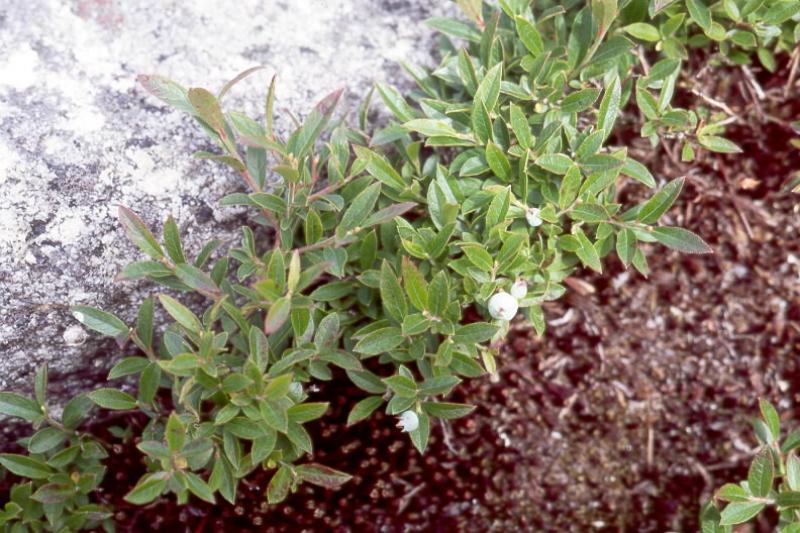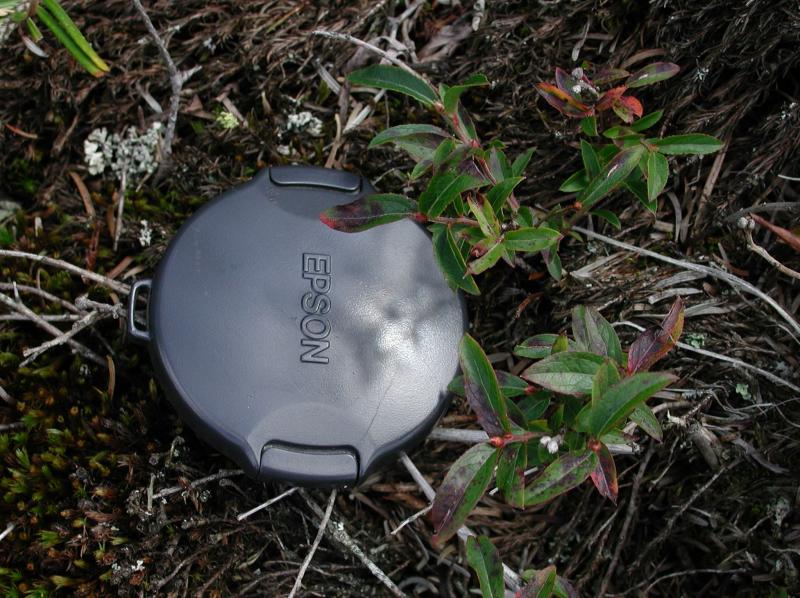Northern Lowbush Blueberry
Vaccinium boreale Hall & Aalders
- Class
- Dicotyledoneae (Dicots)
- Family
- Ericaceae (Heath Family)
- State Protection
- Threatened
Listed as Threatened by New York State: likely to become Endangered in the foreseeable future. For animals, taking, importation, transportation, or possession is prohibited, except under license or permit. For plants, removal or damage without the consent of the landowner is prohibited.
- Federal Protection
- Not Listed
- State Conservation Status Rank
- S2
Imperiled in New York - Very vulnerable to disappearing from New York due to rarity or other factors; typically 6 to 20 populations or locations in New York, very few individuals, very restricted range, few remaining acres (or miles of stream), and/or steep declines.
- Global Conservation Status Rank
- G4G5
Apparently or Demonstrably Secure globally - Uncommon to common in the world, but not rare; usually widespread, but may be rare in some parts of its range; possibly some cause for long-term concern due to declines or other factors. More information is needed to assign either G4 or G5.
Summary
Did you know?
It was not until 1961 that high-mountain blueberry was recognized to be a distinct species due to its superficial similarity to the low sweet blueberry (Vaccinium angustifolium).
State Ranking Justification
There are 16 known populations. One additional population has not been seen since 1948, although more survey work is needed before this population can be determined to be extirpated. All of the populations are restricted to Essex County in the high peaks region of the Adirondacks. There are also a few reports and records from Clinton, Hamilton, Franklin, and Genesee Counties, but these need to be verified.
Short-term Trends
At least some populations have been negatively impacted by trampling from hiker traffic in the recent past although data indicating how much has been lost is not available. Other data on short term trends is not clear. Therefore, this species has probably declined at least a little in the short term.
Long-term Trends
One high peaks population has not been seen since 1948 but more survey work needs to be conducted before it can be determined if this population has become extirpated. There is no clear data on how the extant populations have done in the past 100 + years.
Conservation and Management
Threats
Trampling by hiker traffic is known to be a threat at a majority of the populations.
Conservation Strategies and Management Practices
The Summit Steward program which works to inform hikers of the fragile nature of alpine plants is a critical program which is helping to reduce trampling of alpine vegetation. This program and other efforts designed to reduce trampling of alpine meadows are needed.
Research Needs
Herbarium and perhaps field work are needed to verify the reports of this species from Clinton, Franklin, Hamilton, and Genesee Counties. Additional survey work is needed at the one high peaks population, known from historical records, to determine if that population is still extant. Further survey work in the high peaks region may turn up additional populations. Clear and consistent estimates of population size at extant populations is needed to help determine the trend of this species.
Habitat
Habitat
In New York this species grows exclusively in high alpine settings. Mostly it is in open alpine meadows but it can also grow on exposed rock and openings in krummholz at high elevations (New York Natural Heritage Program 2007). Alpine meadows and exposed, rocky sites (Gleason and Cronquist 1991). Forest-tundra, alpine meadows, and exposed coastal headlands, occasionally on open rocky uplands of Newfoundland. It is an integral part of the cladina-moss carpet between heath hummocks, from which it emerges 1 or 2 cm. It occurs on exposed headlands with Sibbaldiopsis tridentata, Vaccinium vitis-idaea, Danthonia spicata, or Deschampsia flexuosa or on the windswept hummocks of V. uliginosum, Empetrum nigrum, and Cornus canadensis, or on high moors in Sphagnum cushions. In every case, it is part of the ground-level vegetation rather than part of the shrub layer where V. angustifolium occurs (Vander Kloet 1977).
Associated Ecological Communities
- Alpine krummholz
(guide)
A dwarf woodland dominated by balsam fir that occurs at or near the summits of the high peaks of the Adirondacks.
- Open alpine community
(guide)
An open community consisting of a mosaic of sedge/dwarf shrub meadows, dwarf heath shrublands, small boggy depressions, and exposed bedrock covered with lichens and mosses. The open alpine community occurs above timberline (about 4,900 ft or 1,620 m) on the higher mountain summits and exposed ledges of the Adirondacks. The flora includes arctic-alpine species that are restricted (in New York) to these areas, as well as boreal species that occur in forests and bogs at lower elevations. The soils are thin and organic, primarily composed of peat derived from peat mosses (Sphagnum spp.) or black muck. The soils are often saturated because they can be recharged by atmospheric moisture.
Associated Species
- Agrostis mertensii (northern bent)
- Betula glandulosa (alpine birch, resin birch)
- Carex bigelowii
- Cladina rangiferina
- Diapensia lapponica var. lapponica
- Empetrum eamesii ssp. atropurpureum
- Empetrum nigrum ssp. hermaphroditum
- Geocaulon lividum (false toadflax)
- Hierochloe alpina ssp. orthantha
- Huperzia appressa (mountain firmoss)
- Loiseleuria procumbens
- Prenanthes nana
- Rhododendron lapponicum var. lapponicum
- Salix uva-ursi (bearberry willow)
- Solidago leiocarpa (Cutler's alpine goldenrod)
- Trichophorum caespitosum
- Vaccinium uliginosum (bog bilberry)
Range
New York State Distribution
In New York, Vaccinium boreale is restricted to the high peaks region of the Adirondacks in Essex County. There are a few reports and records of this species occuring in other parts of New York (Clinton, Franklin, Hamilton, and Genesee Counties) but these need to be verified. New York is at the southwest edge of the range of this species.
Global Distribution
This species occurs from northeastern Quebec and Labrador south to Newfoundland, Nova Scotia and the mountains of northern New England and New York.
Identification Comments
General Description
High mountain blueberry is a dwarf low shrub that grows in dense colonies. It grows no more than about 3.5 inches tall. The twigs are covered with small warts and have arched hairs arranged in lines. The bright green leaves are up to about 7/8 of an inch long and a quarter as wide. They are not hairy, and have fine, sharp, gland-tipped teeth along the margins. The cylindrical flowers are white to greenish-white. The fruits are blue, about 1/8 to 1/4 inch in diameter, and like those of its close relatives, sweet and tasty (Vander Kloet 1977).
Identifying Characteristics
Vaccinium boreale has superficial rhizomes. The twigs have arched hairs in lines along grooves. The narrowly elliptic leaves are 2-6 mm wide and 8-21 mm long. The corolla is 3-4 mm long. It is diploid with 2n=24.
Best Life Stage for Proper Identification
This species can usually be distinguished vegetatively from Vaccinium angustifolium but the two are very similar so corolla length is a useful additional character to use. Therefore, it is best to identify this species when it is in flower.
Similar Species
Vaccinium angustifolium can be very similar and the two can grow together. Vaccinium angustifolium is taller (over 9 cm high), has leaves 6-17 mm wide, corollas 4-6 mm long, and blooms about 2 weeks earlier. In comparison, V. boreale is shorter (rarely getting to 9 cm high), has leaves 2-5 mm wide, and corollas 3-4 mm long.
Best Time to See
This species starts to flower in very early July and blooms throughout most of that month. Therefore, the best time to survey for this species is early to mid-July.
- Vegetative
- Flowering
- Fruiting
The time of year you would expect to find Northern Lowbush Blueberry vegetative, flowering, and fruiting in New York.
Northern Lowbush Blueberry Images
Taxonomy
Northern Lowbush Blueberry
Vaccinium boreale Hall & Aalders
- Kingdom Plantae
- Phylum Anthophyta
- Class Dicotyledoneae
(Dicots)
- Order Ericales
- Family Ericaceae (Heath Family)
- Order Ericales
- Class Dicotyledoneae
(Dicots)
- Phylum Anthophyta
Additional Common Names
- alpine blueberry
- sweet hurts
Synonyms
- Vaccinium pennsylvanicum var. alpinum Wood [According to Vander Kloet 1977]
- Vaccinium pennsylvanicum var. angustifolium (Aiton) Gray [According to Vander Kloet 1977]
Comments on the Classification
In 1961 Hall and Aalders (1961) described Vaccinium boreale. They indicated that many morphological characteristics that distinguish V. angustifolium from V. boreale can overlap. Subsequent work by Vander Kloet (1977) helped justify the recognition of this taxon at the species level. Hybridization attempts between Vaccinium angustifolium and V. boreale have failed (Vander Kloet 1977).
Additional Resources
Best Identification Reference
Haines, A. and T.F. Vining. 1998. Flora of Maine, A Manual for Identification of Native and Naturalized Vascular Plants of Maine. V.F.Thomas Co., Bar Harbor, Maine.
Other References
Gleason, Henry A. and A. Cronquist. 1991. Manual of Vascular Plants of Northeastern United States and Adjacent Canada. The New York Botanical Garden, Bronx, New York. 910 pp.
Hall, I.V. and L.E. Aalders. 1961. Cytotaxonomy of Lowbush Blueberries in Eastern Canada. American Journal of Botany 48: 199-201.
Holmgren, Noel. 1998. The Illustrated Companion to Gleason and Cronquist's Manual. Illustrations of the Vascular Plants of Northeastern United States and Adjacent Canada. The New York Botanical Garden, Bronx, New York.
Mitchell, Richard S. and Gordon C. Tucker. 1997. Revised Checklist of New York State Plants. Contributions to a Flora of New York State. Checklist IV. Bulletin No. 490. New York State Museum. Albany, NY. 400 pp.
New York Natural Heritage Program. 2010. Biotics database. New York Natural Heritage Program. New York State Department of Environmental Conservation. Albany, NY.
New York Natural Heritage Program. 2024. New York Natural Heritage Program Databases. Albany, NY.
Reschke, Carol. 1990. Ecological communities of New York State. New York Natural Heritage Program, New York State Department of Environmental Conservation. Latham, NY. 96 pp. plus xi.
Vander Kloet, S. P. 1977. The taxonomic status of Vaccinium boreale. Can. J. Bot. 55: 281-288.
Weldy, T. and D. Werier. 2010. New York flora atlas. [S.M. Landry, K.N. Campbell, and L.D. Mabe (original application development), Florida Center for Community Design and Research http://www.fccdr.usf.edu/. University of South Florida http://www.usf.edu/]. New York Flora Association http://newyork.plantatlas.usf.edu/, Albany, New York
Links
About This Guide
Information for this guide was last updated on: December 30, 2008
Please cite this page as:
New York Natural Heritage Program. 2024.
Online Conservation Guide for
Vaccinium boreale.
Available from: https://guides.nynhp.org/northern-lowbush-blueberry/.
Accessed July 26, 2024.

